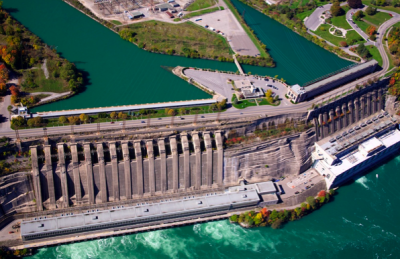Niagara is a lasting beacon of clean and sustainable energy generation in Ontario
Niagara Falls and the Niagara River are Ontario icons because of their natural beauty and massive potential for hydroelectricity generation. Ontario Power Generation (OPG) – the province’s publically owned electricity generation company – is currently constructing a massive tunnel to allow more water from the Niagara River to reach the Sir Adam Beck complex, which generates clean and renewable hydroelectric power.
Sir Adam Beck I and II Hydroelectic Power Stations – Photo by: Dave Mitchell
‘Balancing the natural beauty of Niagara Falls’ is a research project at Carleton’s School of Public Policy and Administration (SPPA) that is investigating the implications of this new tunnel on sustainable energy generation, tourism and recreation, as well as international cooperation between Canada and the United States. This project is supported through a Social Sciences and Humanities Research Council (SSHRC) 2011 Insight Development Grant, which was awarded in July 2011. This project is led by Carleton SPPA faculty member Prof. Stephan Schott and is being conducted in partnership with Prof. Bryan Karney at the University of Toronto’s Department of Civil Engineering. The project has so far engaged two SPPA graduate students as Research Assistants. The research is focused on examining a number of areas, including:
• Historical developments that shaped the 1950 treaty, which governs water diversion for power generation between Canada and the United States.
• The relationship between water diversion for power generation and tourism as well as recreational activities in the Niagara region.
• Cost-benefit analysis of different rates of water diversion given the treaty restrictions, different seasonal variations in water flow, and electricity pricing.
The project is multidisciplinary in nature, incorporating elements of public policy, engineering, economics, international relations, and history in the research. The activities of the project are actively engaging sustainable energy researchers, policy makers in Ontario’s energy sector, graduate students, and the private sector. A forthcoming paper from the project, ‘Sustainable power and scenic beauty: historical developments that led to the 1950 Niagara River Water Diversion Treaty’, was recently accepted to be presented at the 2012 Ontario Network for Sustainable Energy Policy (ONSEP) Workshop.
This project is expected to have a number of outcomes. First we will estimate the potential gains with the new tunnel under status quo limitations for power generation and displaced carbon emissions from dirtier technologies. In addition we will evaluate the optimal distribution of water flow between the power and tourism sectors and ecological services. The results are expected to assist in possible reallocation of water shares between different sectors and a possible revision of the Niagara River Water Diversion Treaty of 1950. We also expect to quantify the costs of remaining under status quo restrictions.
The research findings and resulting policy recommendations will be shared with numerous decision makers and practitioners that are involved in the Niagara tunnel development through presentations and consultations. The research findings will also be disseminated at academic conferences and through peer-reviewed journals that focus on engineering, public policy, economic and legal issues. It is hoped that the project will bring about greater dialogue on the various options for using the new tunnel (other than the status quo) and the resulting implications for stakeholders such as tourists to the region, the cities of Niagara Falls, OPG, New York Power Authority, recreational users and other identified groups.
Written by Andrei Sedoff
Masters MA Public Administration – Innovation, Science & Environment
